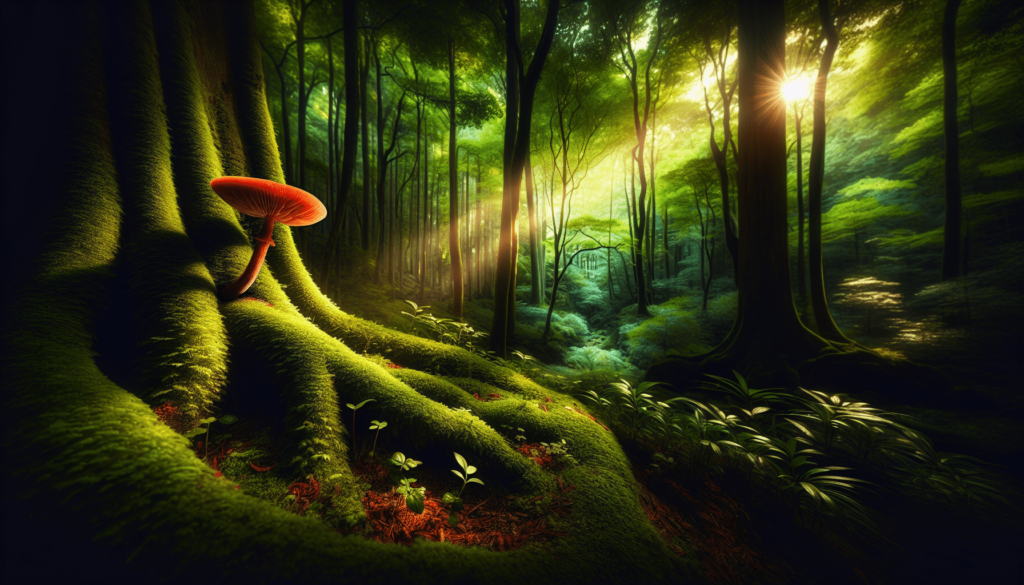Mystical Mushrooms: Foraging In Japan’s Sacred Forests” is your gateway to exploring the enchanting world of mushroom foraging in Japan’s lush and revered woodland areas. You’ll be guided through the most fertile foraging spots, uncovering the seasonal secrets of these mystical landscapes where climate, flora, and fauna create a perfect haven for a myriad of mushroom species. Delve into practical tips on safe and responsible foraging, discover the fascinating culinary and medicinal uses of mushrooms, and connect with the vibrant foraging community through engaging narratives and personal anecdotes. With a strong emphasis on conservation and sustainability, this guide invites you to embark on a respectful and magical foraging adventure in Japan’s sacred forests. Have you ever wondered what it would be like to wander through ancient, sacred forests in search of mystical mushrooms? If your curiosity has led you here, you’re about to embark on a fascinating journey through Japan’s enchanting woodlands. Japan isn’t just about bustling cities and serene temples; its forests are mystical realms waiting to be explored, especially by mushroom enthusiasts like yourself.
This article, “Mystical Mushrooms: Foraging in Japan’s Sacred Forests,” will take you on a comprehensive tour of the most fertile and picturesque mushroom foraging spots in Japan. We’ll delve into regional spotlights, foraging techniques, safety protocols, culinary traditions, and much more. So, grab your foraging basket and let’s get started!

Regional Spotlights and Seasonal Guides
The Regions: A Mycological Goldmine
Japan features a diverse range of forests, from subtropical woodlands in the south to temperate zones in the north. Each of these regions offers unique conditions for mushroom growth. The prime locations include the woodlands of Kiso Valley, the majestic forests around Mount Fuji, and the mystical Nara forests. These regions are ideal for foragers due to their rich biodiversity and well-preserved ecosystems.
Kiso Valley
In the Kiso Valley, you’ll find damp, cool conditions perfect for mushrooms like shiitake, maitake, and reishi. The valley is also known for its ancient cypress trees, giving you a serene and sacred ambiance to enhance your foraging experience.
Mount Fuji
The forests around Mount Fuji are equally remarkable, offering a mix of coniferous and broadleaf trees. Species you might encounter include the luxurious matsutake, known for its strong, spicy aroma and cultural significance.
Nara Forests
Nara, famous for its free-roaming deer, also boasts ancient forests where you can discover both culinary and medicinal mushrooms. The diverse flora and ancient roots make it feel like stepping into a timeless sanctuary.
Seasonal Foraging Guide
Just like any other activity influenced by nature, timing is crucial. Here’s a quick guide on when to forage for some of the most sought-after mushrooms in Japan:
| Season | Common Mushrooms | Ideal Regions |
|---|---|---|
| Spring | Morels, Shiitake | Kiso Valley, Nara |
| Summer | Chanterelles, Oyster | Mount Fuji, Kiso Valley |
| Fall | Matsutake, Maitake | Nara, Mount Fuji |
| Winter | Enoki, Wood Ear | Southern Japan (Kyushu) |
Different mushrooms have different peak seasons, so planning your trip accordingly can increase your chances of a fruitful harvest.
Safety and Ethics of Foraging
Identifying Mushrooms Safely
Foraging for mushrooms is thrilling but comes with its challenges, primarily the risk of encountering poisonous species. Equip yourself with identification guides or apps to help differentiate between edible and toxic varieties. Remember, when in doubt, leave it out!
Responsible Foraging Practices
Respect for nature goes hand-in-hand with foraging. Always practice responsible foraging by:
- Only taking what you need.
- Not disturbing the forest floor excessively.
- Replacing the leaf litter and soil after picking a mushroom to maintain the ecosystem.
Legal Considerations
Different regions in Japan have varying regulations regarding mushroom foraging. It’s essential to familiarize yourself with local laws before setting out. Some forests may require permits, especially in more protected areas.
Leave No Trace
Adopting a “leave no trace” ethos ensures the environment remains pristine for others. This includes taking any litter with you, avoiding damage to flora, and being mindful of wildlife habitats.
Foraging Techniques and Tools
The Essentials
To maximize your foraging success, having the right tools and techniques is crucial. Here’s a brief list of what you’ll need:
| Tool | Purpose |
|---|---|
| Basket | To hold mushrooms without damaging them |
| Field Guide | For identifying various species |
| Knife | For cutting mushrooms cleanly |
| GPS/Map | To navigate safely through the forests |
| Gloves | For handling unknown species safely |
The Process
- Research: Know your mushrooms, their habitats, and their seasons.
- Observation: Explore and observe the forest. Look for decaying logs, moist areas, and tree roots where mushrooms often thrive.
- Harvesting: Use a foraging knife to cut the mushrooms at the base, preserving the mycelium for future growth.
- Recording: Jot down your finds; this helps build your foraging knowledge over time.
Culinary and Medicinal Uses
The Culinary Delights
Japan’s relationship with mushrooms is deeply rooted in its culinary culture. Many traditional dishes incorporate these forest treasures, enhancing their flavors and nutritional value.
Shiitake
A staple in Japanese cuisine, Shiitake mushrooms are known for their umami flavor. They can be grilled, sautéed, or added to soups and stews.
Matsutake
The prized matsutake mushroom is often used in a simple yet exquisite dish called matsutake gohan, where its flavor is preserved by cooking it with rice.
Medicinal Benefits
Apart from their culinary uses, many mushrooms found in Japan are celebrated for their medicinal properties.
Reishi (Ganoderma lucidum)
Known as the “mushroom of immortality,” reishi is used in traditional medicine for its supposed immune-boosting and stress-reducing properties.
Maitake (Grifola frondosa)
Studies suggest that maitake may help regulate blood sugar levels and support the immune system.

Community and Culture
Festivals and Workshops
Mushroom foraging isn’t just a solitary hobby; it’s a communal activity. Japan hosts numerous festivals and workshops dedicated to mushroom foraging and mycology. These events are great places to gain more knowledge, share experiences, and connect with like-minded individuals.
Matsutake Festival
Held annually in various locations like the Tottori Prefecture, the Matsutake Festival celebrates the mushroom season with foraging tours and culinary events.
Foraging Groups
Joining a local foraging group can provide insights and companionship. These groups often organize foraging expeditions, workshops, and meet-ups.
Conservation and Sustainability
The Ecological Role of Mushrooms
Mushrooms play an essential role in forest ecosystems. They help decompose organic material, returning nutrients to the soil and fostering plant growth. Understanding their ecological significance helps in appreciating the need for sustainable foraging.
Sustainable Practices
To ensure mushrooms continue to thrive, always practice sustainable foraging:
- Selective Harvesting: Only take a small portion of the mushrooms you find.
- Monitoring Populations: Avoid over-harvesting in popular foraging spots.
- Spreading Awareness: Educate others about the importance of sustainable foraging.

Engaging Narratives and Personal Stories
A Personal Journey
Emiko, a seasoned forager from Kyoto, recalls her first foraging experience with her grandmother in the Kiso Valley. “I was just eight years old. We woke early, the mist still clinging to the trees. My grandmother taught me how to find shiitake by following the scent of decaying wood. It was magical. From that day, I was hooked.”
Expert Insights
Dr. Hiroshi Tanaka, a local mycologist, emphasizes the cultural and environmental importance of Japan’s forests. “These forests are not just homes to trees and mushrooms; they are living records of our history and heritage. Responsible foraging connects us to our roots and ensures these ecosystems thrive for future generations.”
Conclusion
Foraging for mystical mushrooms in Japan’s sacred forests can be a profoundly enriching experience, weaving together the thrill of discovery, a love for nature, and a connection to age-old traditions. Whether you are a seasoned forager or a curious beginner, Japan offers a mystical culinary and cultural adventure waiting to be explored. So pack your basket, brush up on your mycology, and may your foraging journey be fruitful and enlightening. Happy foraging!

